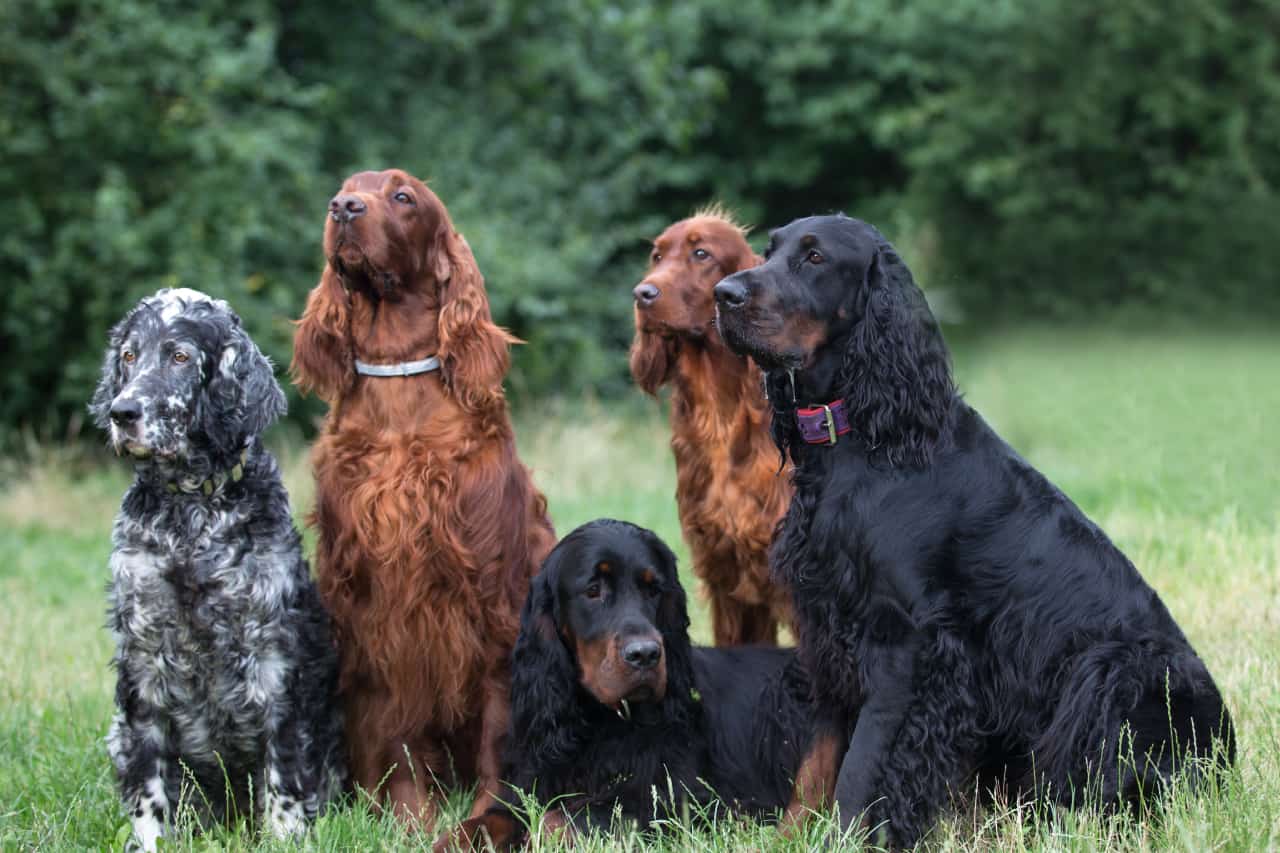Bird dogs are a group of gun or sporting dogs bred to assist during the hunting of pheasants, grouse, quails, ducks, and other types of game and water birds. They are divided into four categories: setters, pointers, flushers, and retrievers. But are these bird dogs just working dogs, or can they be pets as well?
Bird dogs are not just hunting companions. The following 10 bird dogs make wonderful pets:
- Boykin Spaniel
- Brittany
- Cocker Spaniel
- English Cocker Spaniel
- English Setter
- English Springer Spaniel
- Golden Retriever
- Gordon Setter
- Irish Setter
- Labrador Retriever
Bird dogs have worked closely with humans since these breeds were developed. They are not just called hunting dogs, but they are known as hunting companions. However, for a long time, this companionship was limited to the hunting field, and bird dogs were kept in outside kennels instead of joining the family indoors. While some people still adhere to this way of life, most people have invited their bird dogs into their homes and family lives.
Are Bird Dogs Good Pets?
As with most dogs, the answer to this question is absolutely, but for the right owners. Some of them are not ideal for first-time owners or single-person homes where the owners work full-time. This is because of their extremely high energy levels and their attachment to their owners. Hunters who live with their bird dogs report stronger connections and better performance in the hunting fields because of this constant companionship. Even people who don’t hunt keep these breeds exclusively as pets. They are particularly suited to active, experienced, and multi-person homes.
1. Boykin Spaniel
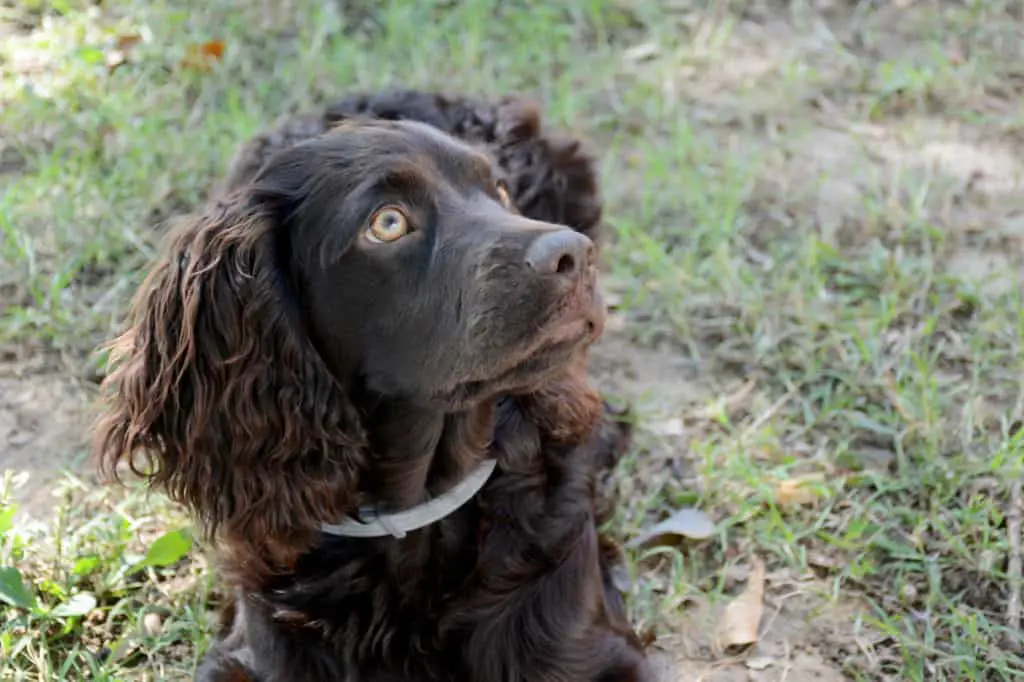
A 20th-century all-American dog, the Boykin Spaniel was bred for flushing and retrieving work in the swamps and lakes of South Carolina, although they are also excellent at land work and are used for hunting wild turkeys.
Boykin Spaniels are not just known for their keen instincts and boundless energy in the hunting field; they are also known to be sweet-tempered, affectionate, and gentle household pets for active owners.
You don’t have to take up hunting if you get a Boykin Spaniel, but you can’t be a couch potato owner! Boykins have medium to high energy levels and are the perfect pet companions for outdoor adventurers such as cyclists, hikers, kayakers, and runners.
Plenty of exercise is needed to keep these dogs from becoming unmanageable; they are not naughty, but excess beans and boredom can lead to unhappy outcomes for both owner and Spaniel. Boykins are not recommended for first-time dog owners.
Training them in agility, field events, obedience, and tracking will provide an excellent outlet for a Boykin’s energy if you do not want to take up hunting. Boykins are eager to please their owners, intelligent, attentive, and focused, making training that much easier and lots of fun.
Unless you live a very active, outdoorsy life in which your Boykin Spaniel can be included, these Spaniels are not suited to apartment living.
Boykin Spaniels aren’t specifically one-person dogs and have enough love and affection for everyone living in a multi-person home. As with all dogs, Boykin Spaniels may gravitate towards one member of a family, but this will not be to the exclusion of the other family members.
Boykin Spaniels can be excellent with young children if they are raised with them. If your Boykin has never be exposed to a small, pull-and-poke-happy child, they may take an understandable exception to this treatment. Older children who understand the correct way to treat a dog and can run and play with the Boykin Spaniel will derive much pleasure from these dogs. So too will the Boykin.
A well-socialized Boykin Spaniel could live happily in a multi-dog home and even a home with cats if they grew up with them. Boykin Spaniels do not have a high prey-drive in terms of killing, but they can be chasers.
If you get a Boykin Spaniel, don’t forget to celebrate September 1st, the official Boykin Spaniel Day in South Carolina!
2. Brittany
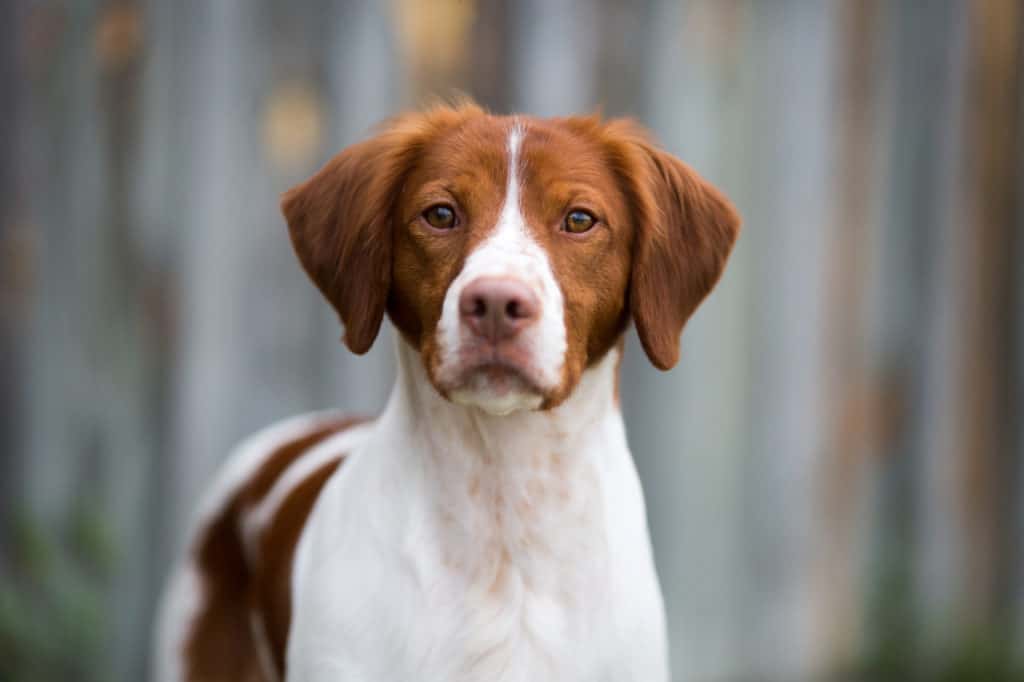
A defining trait of a Brittany is its versatility as bird dogs. Initially, they were called Brittany Spaniels, and indeed, this is still their official breed name in some countries. The AKC decided to drop the ‘Spaniel’ because Brittanys also perform so well as pointers, not just flushers.
Brittanys are not just great bird dogs; their sanguine and jovial personalities make them wonderful pets for active and adventurous owners. They are the perfect companion for cyclists, hikers, kayakers, and runners.
Their friendliness towards people and other dogs means that you don’t have to be worried about taking your Brittany into public places, but if you are looking for a protective dog, look elsewhere!
Brittanys are undoubtedly classed as high-energy dogs. If you get a Brittany, don’t expect them to be happy with sleeping all day and only having a bit of a romp in the evening. Without adequate exercise, a Brittany can become destructive and even neurotic. Brittanys are not suited to apartment living.
Brittanys also need a job to be fully satisfied. They are eager to please and desire both physical and mental stimulation, making them ideal dogs for training in a range of canine events and sports. Their versatility is not just limited to the hunting field; Brittanys are game for anything. However, they are sensitive dogs that respond poorly to harsh treatment, a stern word will be sufficient to check them, and positive training techniques will work best for them.
Brittanys are ideal for multi-person homes—more people to help them to expend their energy! Ditto for multi-dog homes, but you have to make sure that your Brittany is not playing too roughly with small puppies and older dogs. They are great with children, although they can get a little too boisterous for some smaller kids.
3. Cocker Spaniel
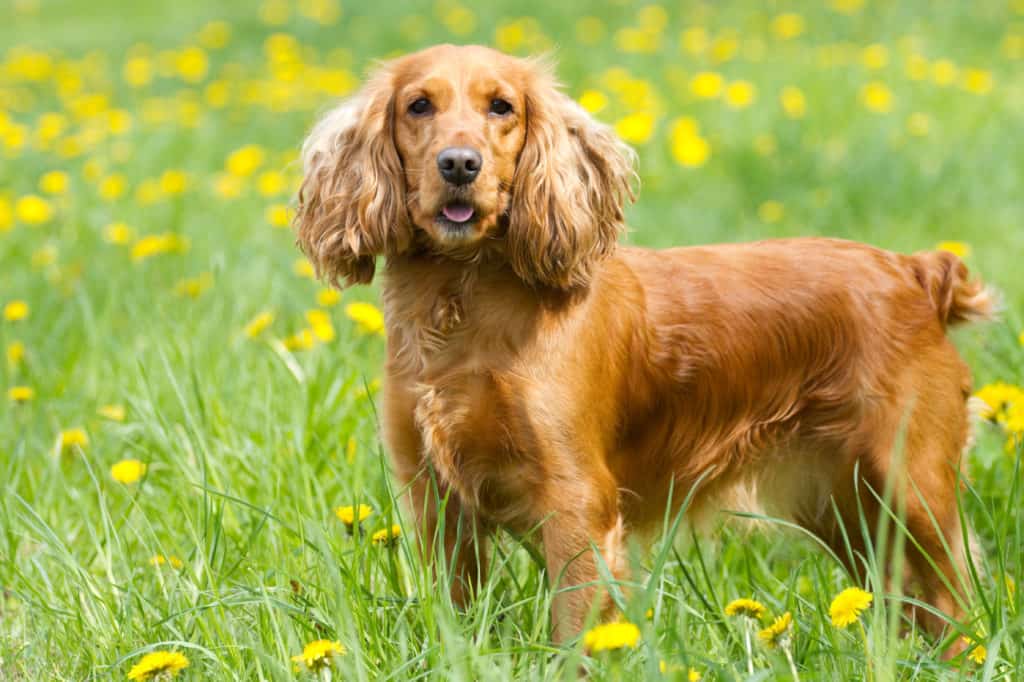
The Cockers Spaniel breed is so named because these dogs were specialized for woodcock hunting. Cocker Spaniels are also known as American Cocker Spaniels. Their luxurious coat and ridiculously long, fluffy ears are not easily reconciled to their status as field-traipsing bird dogs. However, they are excellent flushers, swift, sturdy, and game as a pebble!
Cocker Spaniels are naturally happy, gregarious, and human-orientated dogs—ideal in the role of companion and even therapy dog. They love being with their families and become unhappy when they are left alone for too long.
Cocker Spaniels know their worth and have a tendency towards snappy behavior if handled roughly. This behavior needs to be addressed to prevent it from becoming problematic. You also need to prepare yourself as these dogs can be vocal. They are easily triggered to bark.
Cocker Spaniels have moderate energy levels. One or two brisk walks each day should be sufficient to satisfy their needs. Playtime with their owners is also an ideal way to burn off some of their energy.
Cockers are intelligent and eager to please their owners. They benefit from purposeful, performance-based training, and there are other options if you are not keen on hunting with your Cocker Spaniel. They are sensitive dogs, so positive training methods are best—try food rewards; Cocker Spaniels are easily motivated by food.
With such luscious coats, you can well imagine that their grooming requirements are demanding. Their long ears, especially, can get dirty and need to be checked regularly for possible infections.
Their small frames and moderate energy levels make Cocker Spaniels suitable for apartment living.
Cocker Spaniels can be good with children and other dogs if they are raised with them.
4. English Cocker Spaniel
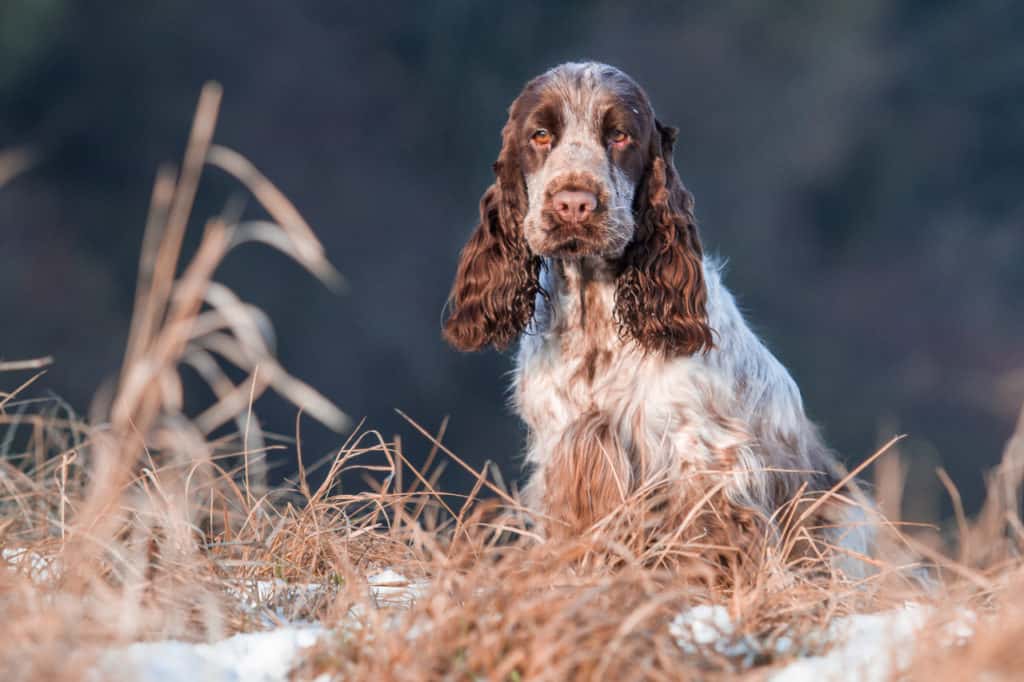
Slightly bigger than their American counterparts, English Cocker Spaniels also have a less domed head, longer muzzle, and short coat than the American Cocker Spaniel.
English Cocker Spaniels are even-tempered and merry dogs. Easy to please and eager to please. However, they can be stubborn, and many English Cocker Spaniel owners will talk about ‘Spaniel Ears’. This does not refer to the long silkiness of the ears but refers instead to their selective hearing. Despite this, English Cocker Spaniels are personable and popular companion dogs. Their tails (and often entire rear ends) are almost always wagging.
English Cocker Spaniels require plenty of attention from their owners, but they can also be quite independent, taking themselves off for adventures whenever the mood strikes them. This can be problematic if you have not fortified your yard!
Like the American Cocker, English Cocker Spaniels have moderate energy levels and exercise requirements. If these daily needs are met, English Cocker Spaniels can live happily in an apartment.
English Cocker Spaniels are intelligent and eager to please their owners. They benefit from purposeful, performance-based training, and there are other options if you are not keen on hunting with your English Cocker Spaniel. They are sensitive dogs, so positive training methods are best—try food rewards; English Cocker Spaniels are easily motivated by food.
English Cocker Spaniels are great in multi-dog households and are happy to play gently with children, particularly if they have been raised with the children.
5. English Setter
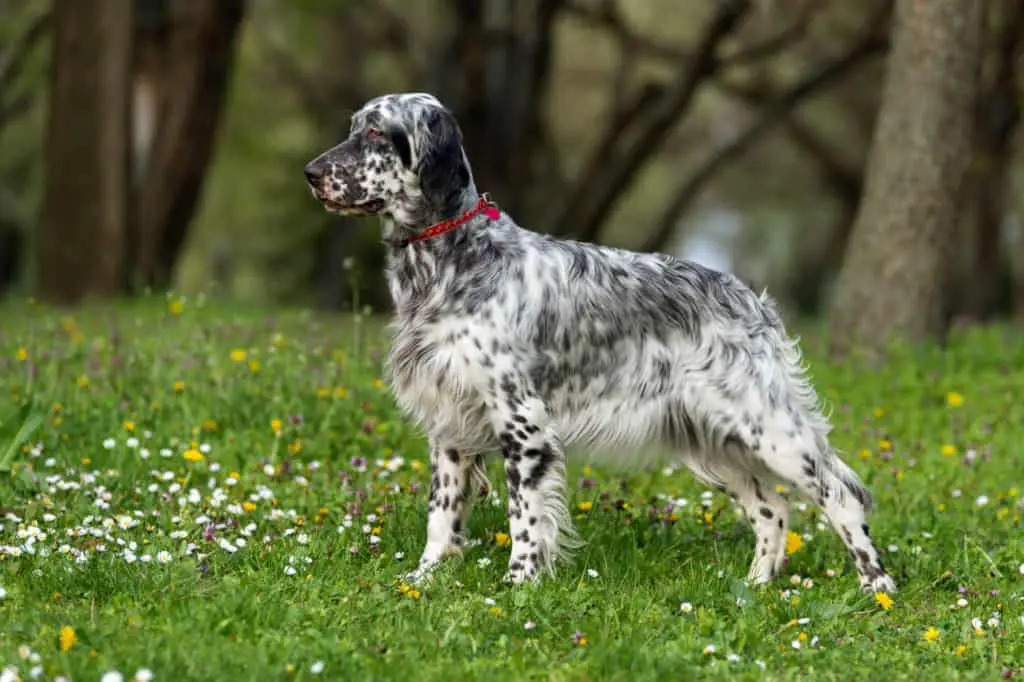
With their distinctive Belton coats and body shape, English Setters can’t easily be mistaken for any other dog breed. Their elegant frame and soulful brown eyes give them the look of a perfect gentleman—which they are!
Befitting the description as gentlemanly dogs, English Setters are sweet and docile (when they receive sufficient exercise). They are friendly, even to strangers, so guard dog is not in their repertoire of skills.
English Setters dislike being left alone and may turn to destructive behavior to demonstrate their frustration and distress. English Setters have a high prey drive and tendency to wander, so off-leash walking is not recommended, and a fortified yard is a requirement.
They have moderate to high energy levels, requiring daily, purposeful exercise. English Setters are excellent walking, jogging, or hiking companions once they are matured, and their joints aren’t at risk of being injured. After such exercise excursions, your English Setter will happily settle down with you for a snooze. Exercise is also important for English Setters because they tend to put on excess weight.
Training is essential to manage their prey drive and tracking instincts. But English Setters are smart dogs and relatively easy to train in multiple canine disciplines, not just hunting. They require consistent, patient, and positive training methods. You should be prepared for a little bit of stubbornness, though.
English Setters are wonderful family pets for multi-person, multi-age, multi-dog homes!
6. English Springer Spaniel
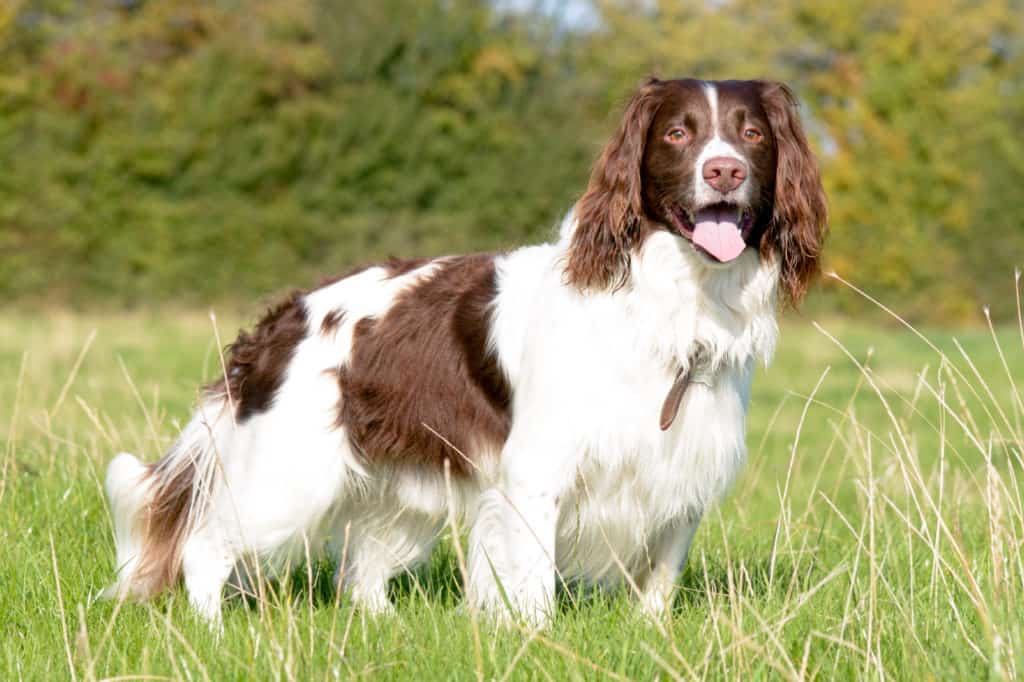
English Springer Spaniels are one of the larger Spaniel breeds. Handsome dogs with kind eyes, they were named after their function in the hunting field. They were bred to flush or spring birds into the open.
English Springer Spaniels are polite, amiable, and playful. They are excellent and faithful companions who will follow you anywhere, even if it is inconvenient for them. Their affinity for their human companions means that they do not like being left alone and can display undesirable behaviors when left alone too long or too frequently.
They require moderate daily exercise to keep them in shape and work off their energy, and they prefer exercising with their owners, whether that is a good walk, a hike, or a lively game of fetch. Even though they only require moderate exercise, they have incredible stamina, one of the qualities that make them excellent bird dogs in the hunting field.
Eager to please and intelligent, English Springer Spaniels derive much physical and mental fulfillment from training. They are ideal for agility, hunting (obviously!), obedience, rally, and tracker training.
English Springer Spaniels can be excellent with young children if they are raised with them. Older children who understand the correct way to treat a dog and can run and play with the Springer Spaniel will derive much pleasure from these dogs. So too will the Boykin.
A well-socialized English Springer Spaniel can live happily in a multi-dog or even a multi-pet home, except their high prey drive and birding instincts means they should not be kept with pet birds.
7. Golden Retriever

What list of bird dogs that make wonderful pets would be complete without the fantastic Golden Retriever? Notably, excellent records of this breed’s beginnings were kept by the Scottish nobleman who first them all the way back in the 1800s. AKC describes Golden Retrievers as “an enduring gift to dogkind from a hunt-happy aristocrat”, and really, we couldn’t say it better.
Ebullient, trusting, and trust-worthy dogs, the Golden Retrievers make stupendous pets. They are bred to retrieve waterfowl from lakes, ponds, and marshes. So, you can expect to spend a lot of time playing fetch with your Golden Retriever, and if they have access to a body of water, however big or small, they will be wet almost constantly.
Golden Retrievers are amiable, even-tempered, devoted, and obedient companions. Goldens will do almost anything to please you, and they dislike being left alone.
Their high energy level means that they need plentiful and daily exercise, but they are not super intense dogs. You can encourage them to burn off some energy through walks and play. They can join you on a hike or a jog but be careful not to take them on strenuous outings as they can struggle with joint problems.
As with all bird dogs, Golden Retrievers are prime candidates for all sorts of canine sports, not just hunting. Golden Retrievers are intelligent and keen to please their owners, so training is easy and provides special bonding time between a Golden and its owner.
If you want an active family pet in a home with children of any age, you can’t go wrong with a Golden Retriever. They are kind, gentle, and patient with their little friends, but they also have enough energy and gumption to keep up with these tireless mini-people.
Golden retrievers are also great with other dogs, cats, and most pets.
8. Gordon Setter

Known as the most substantial Setter, Gordon Setters are a Scottish bred breed of dogs adapted to withstand the harsh and craggy countryside of their country of origin.
Gordon Setters are very affectionate and friendly towards their family, although they are wary of strangers. They develop deep bonds with their particular people. They love to play, particularly with their family, and retain much of their puppyhood enthusiasm for games.
While they can be left alone without problems for a few hours at a time, their orientation towards people means that they prone to developing separation anxiety.
Gordon Setters are loyal dogs with a protective instinct. They are reserved with strangers and will let you know when someone unknown is approaching. They are not quite up to being protective dogs, but they certainly qualify as watchdogs.
While they have high energy levels, Gordon Setters are not very intense dogs. They require daily exercise and room to run, so apartment living is not recommended for these dogs. In a yard, they will exercise themselves, but if you make him your cycling or running partner, your Gordon Setter will be in Heaven!
Training can be tricky with a Gordon Setter because they have a stubborn and independent streak. However, this streak and their naturally high prey drive make training even more important, so stay consistent and make sure you approach the training with confidence, or else your Gordon will take advantage of you. Don’t be scared, though; bird dogs have to be trainable; it’s an innate trait.
Gordon Setters are tolerant and friendly with children, even young children, although a Gordon Setter puppy might out-energy most toddlers and become a bit boisterous.
These Setters are also good with other dogs, but their prey drive is too high to keep them with cats and other small pets.
9. Irish Setter

The striking redheaded Irish Setter is beautiful, capable, and the darling of their families. They excel in the show ring and the field.
They live for companionship with their beloved family and will follow them around the house, inserting themselves into any activity just to be near their people. Naturally gregarious and sweet-tempered, Irish Setters are also a crowd favorite. They will happily befriend strangers and charm them within moments!
With bundles of energy, Irish Setters require dedicated and daily exercise to prevent unwanted behaviors arising out of boredom and frustration. They are best suited to houses with a large, fenced-off yard where they can run, but if things get too quiet, go out and check on them. Irish Setters are curious and capable, so wandering off is not difficult. They are excellent companions to active owners who run, cycle, and hike.
The affable, happy to please, and be pleased Irish Setter should be trained using consistent positive methods. They are intelligent and thrive when trained. If you are not a hunter, sign your Irish Setter up for agility, obedience, rally, tracking, etc.
Irish Setters are fantastic family dogs. Irish Setters are excellent with children of all ages and just love people. Very timid children might feel overwhelmed by their exuberance, but these dogs don’t have a mean bone in their lovely bodies.
Irish Setters are also great with other dogs. They are generally good with cats belonging to their own family. However, they are hunting dogs with high prey drives, so small animals are not ideal in a home with an Irish Setter.
10. Labrador Retriever

Well, and here we come to him. The Labrador Retriever. The AKC’s number one most popular breed—and with good reason! These dogs have been known as wonderful pets for so long that you can easily forget they are actually bird dogs, bred for a hunting field.
Tractability, amiability, loyalty, gentleness, and a strong desire to please their owners are traits that were bred into these dogs centuries ago. And they are still the hallmarks of Labrador Retrievers. These characteristics make them effective retrievers and ideal companions.
As strong companion dogs, Labrador Retrievers can become upset when their humans leave them alone for too long. They can cope with having an owner who has a full-time job, but this owner should be deliberate in spending time with their Labs during their non-working hours. Remember, boredom, energy, and loneliness together are a destructive combination in a dog.
Their high energy levels mean that Labrador Retrievers need plentiful and daily exercise, but they are not super intense dogs. You can encourage them to burn off some energy through long walks and lively play. They can join you on a hike or a jog but be careful not to take them on strenuous outings as they can struggle with joint problems.
As with Golden Retrievers, Labradors are bred to retrieve waterfowl from lakes, ponds, and marshes. So, you can expect to spend a lot of time playing fetch with your Lab, and if they have access to a body of water, however big or small, they will be wet almost constantly.
Labrador Retrievers, as with all bird dogs, are prime candidates for all sorts of canine sports, not just hunting. They are intelligent and keen to please their owners, so training is easy and provides special bonding time between a Lab and its owner.
Anyone looking for an active family pet in a home with children of any age can’t go wrong with a Labrador Retriever. They are kind, gentle, and patient with all companions, but they also have enough energy and gumption to keep up with these seemingly tireless kids.
Labrador retrievers are also great with other dogs, cats, and most pets.
Consider Adoption
Far too often, bird dogs end up in shelters because their owners liked the look or the idea of them but could not handle their energy levels and need for training. If you are looking for a bird dog, consider calling around to shelter, breed rescue, and animal welfare associations. Your perfect canine friend may be waiting for you to be their hero!
Conclusion
Bird dogs are known for their stamina, speed, strength, and spirit. They are amazing working dogs, a pleasure to watch when they are doing what they were bred to do. Until a few decades ago, these working hunting dogs were often kept in outside kennels. But they are actually really great pets. Bird dogs are bred to work closely with humans, and living with humans as well creates very special bonds of loyalty and affection.
There is no one group of bird dogs that make good pets. Spaniels (flushers), Setter, Retrievers, and Pointers are all fantastic in their own way. Some are not suitable for first-time owners because of their high energy levels and resultant exercise and attention requirements, but this does not make them bad pets.
This list by no means excludes the unmentioned bird dogs from being wonderful pets; we simply picked ten from among them.
Bird dogs have made a move from outdoor kennels and hunting fields into hearts and homes, and they aren’t going anywhere!
References
https://www.akc.org/dog-breeds/boykin-spaniel/
https://www.orvis.com/boykin-spaniel
https://dogtime.com/dog-breeds/boykin-spaniel#/slide/1
https://www.akc.org/dog-breeds/brittany/
https://www.orvis.com/brittany
https://dogtime.com/dog-breeds/brittany#/slide/1
https://www.akc.org/dog-breeds/cocker-spaniel/
https://www.orvis.com/cocker-spaniel
https://dogtime.com/dog-breeds/cocker-spaniel#/slide/1
https://www.akc.org/dog-breeds/english-cocker-spaniel/
https://www.orvis.com/english-cocker-spaniel
https://dogtime.com/dog-breeds/english-cocker-spaniel#/slide/1
https://www.akc.org/dog-breeds/english-setter/
https://www.orvis.com/english-setter
https://dogtime.com/dog-breeds/english-setter#/slide/1
https://www.akc.org/dog-breeds/english-springer-spaniel/
https://www.orvis.com/english-springer-spaniel
https://www.akc.org/dog-breeds/golden-retriever/
https://www.orvis.com/golden-retriever
https://dogtime.com/dog-breeds/golden-retriever#/slide/1
https://www.akc.org/dog-breeds/gordon-setter/
https://www.orvis.com/gordon-setter
https://dogtime.com/dog-breeds/gordon-setter#/slide/1
https://www.akc.org/dog-breeds/irish-setter/
https://www.orvis.com/irish-setter
https://dogtime.com/dog-breeds/irish-setter#/slide/1
https://www.akc.org/dog-breeds/labrador-retriever/
